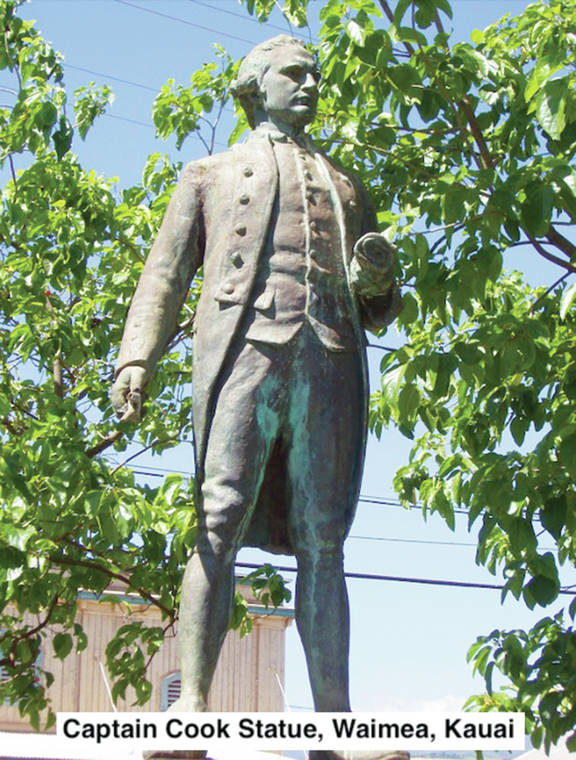In the afternoon of Jan. 20, 1778, Capt. James Cook’s ships, the Resolution and Discovery, dropped anchors off the mouth of the Waimea River on Kaua‘i, and Cook, the British explorer and discoverer of the Hawaiian Islands, made for shore with a guard of 12 armed marines in three boats.
In the afternoon of Jan. 20, 1778, Capt. James Cook’s ships, the Resolution and Discovery, dropped anchors off the mouth of the Waimea River on Kaua‘i, and Cook, the British explorer and discoverer of the Hawaiian Islands, made for shore with a guard of 12 armed marines in three boats.
Meanwhile, hundreds of Hawaiians waited ashore to greet him with offerings of bananas, pigs and kapa.
At the moment Cook stepped from his boat — and in doing so made his first landing in Hawai‘i at a site in what is today called Lucy Wright Park — the commoner Hawaiians on shore fell prone on the ground before him, just as they would have done before their highest ranking ali‘i.
Some 150 years later, on Aug. 16, 1928, sesquicentennial celebrations commemorating Cook’s landing were held at Waimea Park (renamed Hofgaard Park in 1931 in honor of Judge C.B. Hofgaard), and a stone Cook monument was unveiled and dedicated there as well.
Earlier, in the wee hours after midnight of Aug. 16, the battleship USS Pennsylvania, along with its accompanying convoy of submarines, minesweepers and destroyers, anchored off Waimea in the area where Cook’s ships had anchored 150 years before.
Also at anchor were the inter-island liner Wai‘ale‘ale and three British warships: the HMS Cornwall, HMAS Brisbane and HMS Dunedin.
Ship’s boats carrying naval officers, civilian VIPs and 100 sailors from the USS Pennsylvania, 150 British marines, the bagpipe corps of the HMS Cornwall and the Pennsylvania’s band were escorted shoreward in sampans driven by local Japanese and Hawaiians.
Waimea’s black-sand beach and the Waimea Pier were thronged with spectators.
On the pier, 300 Japanese children of the Waimea Japanese Language School waved flags of the United States, Great Britain, New Zealand and Australia.
The USS Pennsylvania band played “Hawaii Pono‘i,” “God Save the King,” “Australia Fair” and “America.”
Mrs. Kalahikiola Hali chanted of Cook’s greatness in the Hawaiian language.
Airplanes circled above the assemblage, dropping flowers.
Dignitaries made speeches in Waimea Park, and a 21-gun salute boomed from each of the four warships.






Shhhh. You shouldn’t have reminded us. Now we must wonder: when will Hawaiian sovereignty activists start vandalizing and then toppling the statue? They’re already demanding the removal of McKinley’s name and statue from McKinley High School in Honolulu, because he pushed the Treaty of Annexation through Congress and, they say, he was a racist (pot calling the kettle black).
I’ve always wondered why Capt. Cooks statue was on Main Street by the bank instead of at the park where the river meets the sea?
Speaking Truth to Power at the University and International level….. disputes most of these false claims in the article and Ken’s comments!
Here is the real deal about Hawai’i past, present and future.
I beg you educate yourself!!!
HAWAIIANKINGDOM.ORG